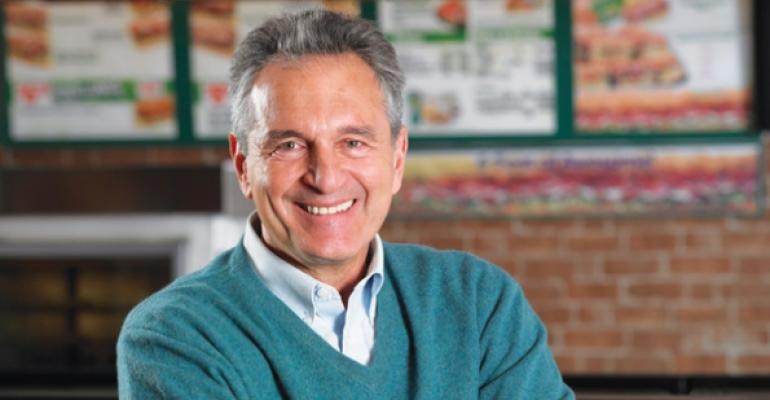As the nation’s largest restaurant chain in terms of worldwide unit count, Subway’s growth trajectory seems unstoppable.
The Milford, Conn.-based chain is projected to top 40,000 units this year, and the franchisor is working hard to plant the seeds of brand awareness around the world to spark both franchise operator interest and generate employees for the growing chain.
It all started with one sub shop in Bridgeport, Conn. — Pete’s Subway — opened in 1965 by the then-17-year-old Fred DeLuca with $1,000 borrowed from Dr. Peter Buck, who would become his business partner.
In a recent conversation with Nation’s Restaurant News, DeLuca discussed Subway’s ongoing growth plans worldwide:
This year Subway’s goal is opening 3,000 units globally, including 1,000 in North America. You’ve been quoted on a goal of hitting 45,000 by 2015. Is that possible?
I think so. In 2013 we’ll be up over 40,000. Last year we gained a little over 2,500 stores, and the year before was closer to 2,000. Throughout the year we ramped up, so the question is: Will we continue to ramp up to 3,000? I think 2,500 is a pretty safe number.
A recent video about the chain suggested Subway could hit 100,000 by 2030.
That’s not so much a goal. Ever since the 1990s, I’ve said there will be a big fast-food company with 100,000 stores — someone will get to 100,000 — because I could see the way the world was changing. People gravitate toward brands. Big chains are getting bigger. Many are global now. Looking at growth of the world and changing economics, I felt pretty confident that would happen. Of course when I first said that, we were teeny, and the obvious choice to accomplish that would be a company like McDonald’s. But we could do it. It’s possible. And they could do it, too.
So will we? I’m not ready to commit to a 100,000-store goal. Certainly, it will take a long time. I’ve been at this all my life, and we’re not even at 50,000!
How would you characterize growth around the world now? I’ve heard company officials talk about Subway growing in Asia, Latin America and Europe this year.
North America and Australia grow at a very good pace, but Australia is a peanut of a place, relatively. That’s not where the people are. The people are in Asia, Latin America, Europe. Those places will constitute a lot of growth. The Middle East, too.
You’re in about 100 countries now. Any goals in terms of where you’d like to be five years from now?
No country goal. I suspect we’ll be in more, but maybe not a lot more. The countries we’re in are clearly the more prosperous countries with bigger populations. Five years from now I’d guess we’ll be in 110 or 115 countries.
Would you say the push is to grow more outside the U.S.?
We’ve been growing at about 1,000 stores per year for quite a few years in the U.S. International is where the much bigger long-term opportunity is, only because that’s where all the people are. The trick is reaching the middle class, getting to the average man and doing more of a mass-market product. We’re making some nice progress there.
Before the recession, Starbucks was once criticized by some for being ubiquitous in the U.S. There was a Starbucks on every corner, it seemed. Do you feel like there is a saturation point for Subway?
Yes, but I don’t know where the saturation point is. I take all of our territories and look at the highest-density stores compared to the lowest. I look at sales and whether we have stopped growth or hit the wall in some way. And the odd thing is the highest-density territories either equal or exceed the performance of the territories that are less dense. So it’s not like they’re slowing down, which tells me they haven’t hit the wall yet.
These high-density stores are in markets that have about one Subway store for every 8,000 or 10,000 people. That group is doing just fine. Certainly, there’s a limit to any brand, and it may seem like we have stores everywhere. But in reality, on any given day, less than 2 percent of the population eats at Subway. The number we use is 1.7 percent. Three percent is within the realm of reason, and that would be a huge increase from where we are now. There are a lot more sandwiches to make.
Contact Lisa Jennings at [email protected].
Follow her on Twitter: @livetodineout.

